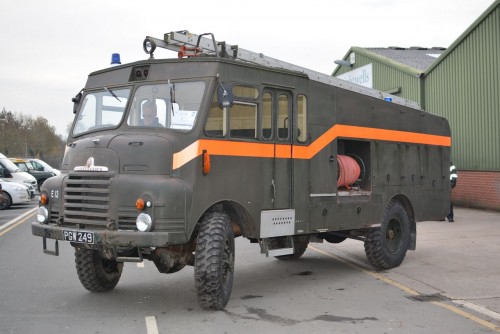
Click Here for Full Screen Image - Click Here to Download Image
 |  |  |  |  | |||||
 |  |  |  |  | |||||
 |  |
| Lot number | 64 |
|---|---|
| Hammer value | £3,000 |
| Description | Bedford RLH 'Green Goddess' Fire Engine |
| Registration | PGW 249 |
| Year | 1956 |
| Colour | Green |
| Engine size | 4,900 cc |
| Chassis No. | RLHZ8078 |
| Documents | V5C; handbooks; maintenance manual; period log sheets etc |
When it comes to the arms race of who has the best toys, it always helps to have something really chunky in your arsenal, like a fire engine.
Made between 1953 and 1956, the Bedford RLH, or ‘Green Goddess’ as it was popularly known, wasn’t technically a fire engine but a ‘self-propelled auxiliary pump’ (but who’s splitting hairs?). Based on the military Bedford RL chassis, the two-wheel drive versions had a 400 gallon water tank and the 4x4 versions 300 gallons. Not only could they access remote areas, they could also be linked into relays to pump very large quantities of water from one place to another.
Commissioned during the Cold War to help cope with the aftermath of a Soviet nuclear attack, it takes some imagination to see what these lumbering machines might have achieved in such a catastrophic eventuality. Perhaps their mere presence boosted civilian belief in the Government’s ability to do something useful in such dreadful circumstances?
Mothballed in 1968, they were nonetheless maintained and regularly road tested, being pressed into action during the drought of 1974 and during the firemen’s strikes of 1977-79 and 2002-03 in the hands of the army. They were an odd sight as they struggled along fully laden with water at their 40mph top whack.
Finally decommissioned in 2004, most of the 1,000 strong fleet were sold to fire brigades in developing countries but a few found their way into private hands, attracting the same kind of buyer who had previously snapped up the old Routemaster buses and the iconic K-Series red telephone boxes.
Brought into service in April 1956, this late model Green Goddess appears to have spent most of its life at Branston, Lincolnshire, remaining in Government hands until it was finally pensioned off in 2007 when the vendor acquired it. Said to run very sweetly and regularly serviced while in the current ownership, it shows less than 3,500 miles on the clock which is probably correct as most of these vehicles spent the vast majority of their lives on standby in MOD depots dotted across the country.
One of the most pleasing things about this vehicle is that it remains complete in virtually every respect, the lockers still full of period fire-fighting equipment and pumping paraphernalia plus, of course, the obligatory ladders for rescuing old ladies stuck up trees. Better still, it also retains considerable documentation including copies of the original operating instructions and maintenance manuals, and even the original log sheets and record book, unique to each vehicle and charting deployment and maintenance while in service.
Adding up to a fascinating package of Cold War era memorabilia, this is an ensemble that needs to be preserved for future generations to ponder. Not to mention the 'boys toys' bragging rights it will confer on the lucky new owner down at the pub...